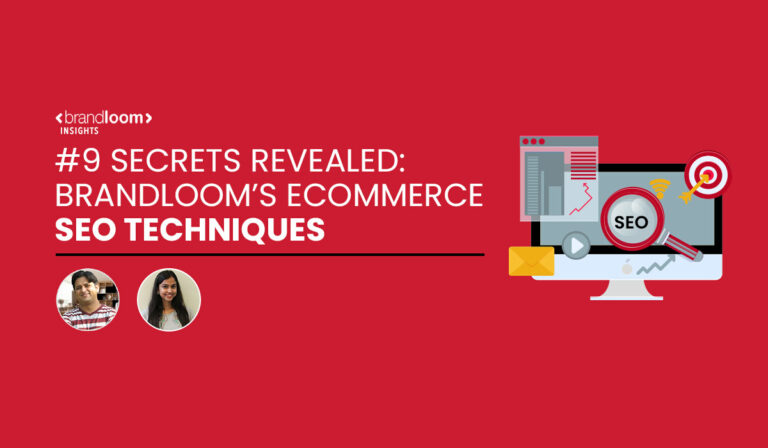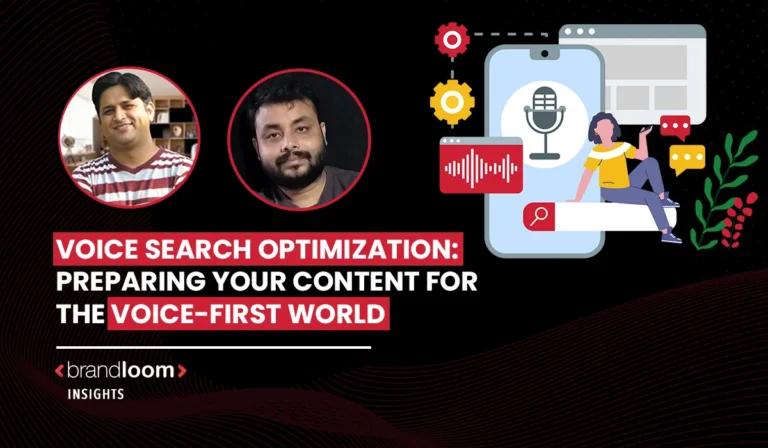Many dreams of finding their target audience and selling their products online. And there is still a lot of work to be done once your online store is ready. The trick to attract customers to your product page is the most difficult, but all of its solutions lie in ecommerce seo techniques.
Ecommerce SEO is nothing but simple search engine optimization for an e-commerce store.
The faster your page appears on the Google search results in searching a keyword, the more chances you have to get clicked.
Suppose a keyword is searched and your page shows up at the first position; then it will get about ten times higher clicks than the website placed at the tenth position.
The websites on the second page of the search result get less than 1% clicks. Hence BrandLoom offers eCommerce SEO services to ensure there is always a way to make those sales.
With our SEO efforts, you can rank higher in search results, and people are more prone to find you. The more traffic you get, the more chances you have to make sales.
So let’s find out our recommended 9 SEO strategies for eCommerce websites.
SEO Strategies for eCommerce Websites
1 Improve eCommerce SEO with effective keywords
Each word that people search for online is a keyword.
You must focus on the terms related to your industry and relevant to your audience so that your page can rank higher in search results when people search for it.
The number of keywords you want to target for your pages is your choice, but you must focus on distributing the target keywords throughout your content.
You must also make sure that the target keywords are interrelated.
It would be best if you taught google what your page’s content is about so that it shows your content as soon as a keyword is searched.
Instead of using too many keywords, focus on one or two and distribute that well across the content.
Here are some tips for keyword research.
- Start with basic knowledge: You must consider keywords for which your product or service would be used. That’s the step to begin your keyword research journey.
- Utilize the data: Collect the data of all the keywords people have been using for so long to find your product on google. Implement them into your content to make it more SEO friendly.
- Specification: The common keywords are always broad. For example, ‘bikes’ and ‘petrol pumps’ are always more likely to get more extensive searches than the keywords like ‘double silencer bikes,’ ‘petrol pumps near Andheri,’ and so on. However, the chances of you ranking for broad keywords are limited. To increase traffic to your site, go for long-tail keywords.
- Put yourself in the user’s shoes: This is the most fundamental concept of making any sale. Think like a customer to understand their intent. Consider what a customer may think while searching for a product you offer. For example, you can use specific keywords like ‘branded t-shirt with one-day delivery’ or ‘jewellery shops with hallmark certifications.’ These kinds of purchase-related keywords are more likely to lead to conversions.
2. No Duplicate content: Ignored eCommerce SEO Technique
Any content on any other website similar to yours is a duplicate. Make sure you don’t create such content for your website. This is one of the most often ignored eCommerce SEO Techniques, and you must avoid it.
The search engine gets confused with such content as it cannot decide which content to place first and which to place later when both are similar. It is never sure which content is more accurate, which puts you at a disadvantage.
Here are a few tips to avoid duplicate content.
- Avoid copying content from other websites: Even though your product or service is similar, try to have uniqueness in your content by preparing a product description of your own.
- Describe each product separately: Though your products might be similar, you must still write separate sets of features and characters for each.
- Keep track of your URLs, including any link, Id, code, etc.
3. Enhance e-commerce SEO with good product descriptions
Apart from the product title, pictures and price, the description should also contain the item’s detailed characteristics and speciality. You can also add features that distinguish the article from all competitors.
You can start talking about the information that excites your target audience, such as measurement, instructions, range, colour, etc. Being descriptive and detailed is the best option.
You can keep the reader’s attention converged by putting interesting questions that may arise in their mind. For example, ‘Will the t-shirt serve as gym wear?’, ‘Does the fabric cause irritation when the skin is sweaty?’, etc.
Be detailed with your opening lines for your product. Does the scent of your perfume transport you to a fall forest? Is your V-line dress perfect for an evening out on the town?
Write about that. Also, always use the keywords naturally instead of just stuffing them forcefully. The unnecessary repetition of the keywords causes the readers to lose interest in the product description.
Let us understand with a few examples. Consider you are selling a toddler’s backpack. So, it would help if you did not write: ‘We sell good quality toddler backpacks. Our toddler’s backpack is just $120. The toddler’s backpack available from our website will be delivered within two days. Your kid would love to use our toddler’s backpack.’
It does not sound natural, does it? So, before making too much SEO effect in your article, you must focus on the likes and dislikes of your readers. The text must not be monotonous.
4. User-friendly URL: One of the ignored eCommerce SEO Techniques
Always try to get the best out of your URL. Your URL must indicate what your content is all about. Also, keep the URL short.
For example, instead of making a URL for your dog food selling website, like example.com/store/products/374820/show, you can make it like: example.com/store/dog-food. This helps google to identify the content on your website.
This one is one of the most ignored eCommerce SEO Techniques.
5. Alt text- Technical SEO ecommerce
The search engine can not read your images. The alt text is the only way Google can figure out the meaning behind various images.
The concept of alt text is based mainly on the caption below the image. Try to include the keywords in the caption and the image description.
The description should be such that one can understand the content of the image without seeing the image.
Blind people also use these alt texts as screen readers. It is not always necessary to put keywords in the caption, but if it fits the image meaning, definitely include it.
This one is one of the most ignored eCommerce SEO Techniques.
6. Use Google Ads to test your targets.
You may put a lot of effort and money into attracting people to your product page, but very few of your target audience will purchase your product.
The most trending way to attract the right target audience to the page is through Google ads.
The purpose of these ads is to make your content visible to those targeted customers only, immensely increasing the chances of conversions.
This one if one of the most ignored eCommerce SEO Techniques.
7. No broken links for Effective eCommerce SEO
Broken links make it difficult for search engines to rank your content and make it a struggle for the users to understand the content of your website.
Authority links are also essential for developing trust among users. To ease the difficulty of monitoring those links manually, you can use SEO tools such as the Broken Link Checker plugin.
This one if one of the most ignored eCommerce SEO Techniques.
8. Speed up your site
If you can save your users’ time, they will be more likely to visit your ecommerce site. Speeding up your site so it takes less time to open is very beneficial for your customers. Follow the underlying tips to make your page load faster.
- Image optimization: Optimizing your images is a great way to reduce page speed. A good optimization tool retains only some images in large sizes, which is necessary. The size of other images would reduce significantly. All the media files would be compressed as much as possible.
- Caching: Plugin such as WP Super Cache will save a copy of the website once the user has visited the site. The page will be loaded faster if the same user comes again later.
- Consider a CDN. A content delivery network stores heavy files outside the website so that they load faster. It also loads your website from distributed servers closest to the location of all individual site visitors.
- A good host can effectively boost the speed of loading the content on your product page.
- Use a few necessary plugins. Unnecessary plugins increase the time for the content to be loaded.
9. Smart use of anchor text.
Another interesting way to attract more users to your site is using relevant anchor text.
You can put internal links to all your other pages, including similar content, for example, all the topics related to indoor fitness.
This would help google understand the connection between all your pages. Also, try to use the target keywords in the anchor texts if possible.
For example, don’t write ‘click here to know more about Lenovo Laptops
Instead, you can write, ‘Here is our list of other information about the user-friendly Lenovo laptops.’
This one if one of the most ignored eCommerce SEO Techniques.
Conclusion: eCommerce SEO Techniques
With the rapid change in SEO technologies, e-commerce stores are advancing to survive in the market.
The above-mentioned tactics are effective practices that would effectively suit googles algorithm changes.
To ensure the growth of the business, you must make it clear that your e-commerce store can cope with the rapid changes in the algorithms of search engines. If you are unsure how to get that done, you can reach out to BrandLoom.
Frequently Asked Questions on eCommerce SEO Techniques
Ecommerce SEO is just like any search engine optimization technique of an online store. It includes writing long descriptions and putting relevant keywords wherever possible on every product page. This is an example of optimization. Another example is obtaining backlinks from relevant websites to improve your online store’s ranking.
It is the process of generating more organic (non-paid or free) traffic from search engines like Google, Bing, and Yahoo to your online store. E-commerce SEO ensures that your website appears among the top 10 organic search results. Thus, you can gather more visitors on your web page and make sales.
E-commerce stores can greatly benefit from SEO. Many agree that e-commerce stores must focus more on SEO for ranking and customer acquisition purposes.
The most popular practice is to place keywords evenly throughout the content. You have to make sure it doesn’t look spammy.
This would gather more viewers as the search engine would be convinced that your page is the solution for the particular query made by your target audience.
SEO in digital marketing has always been necessary, but it is necessary for e-commerce and other business websites. Learning the ins and outs of e-commerce websites and optimizing your product page for your target audience is best.
SEO is important for e-commerce as it ranks the page higher on search engines. The more SEO-friendly your content is, the more visitors your online store will get, and as a result, the more sales you will make. You will be less likely to spend on advertisements, decreasing your net cost.
E-commerce websites allow you to sell or purchase products online without physically visiting the stores. It contains all the product information one gets from a local store, sometimes even more than those.
The other non-eCommerce/regular websites contain educational or social information that will teach people something new.
E-commerce websites are intended to sell their goods or services and not just gather viewers. Along with viewers, they demand customers for their products.
So, instead of focusing on readable language and catchy headlines, they aim to lure visitors into buying their goods. If you have an e-commerce website, your primary aim is to gather readers and make them feel that your product is perfect for satisfying their needs.
The visitors to your website will be boosted if your website provides great shopping experiences to them.
Make every minor thing convenient for your users, such as creating a new account, logging in to an existing account, easy payment methods, accurate product descriptions of all the items, realistic pictures of the items, reasonable prices, convenient delivery, options for saving the articles of their voice and so on.
After you have brought customers to your website and made them go through all the content, make sure you provide them with a fantastic user experience. You must make the checkout process clean and seamless, so they would love to come and buy again from you.
Search engine optimization (SEO) is optimizing your website and its content to rank higher in search engine results pages (SERPs) and attract more organic traffic. SEO is important for eCommerce websites because it can help improve visibility and attract potential customers who are searching for products or services related to your business.
Here are some tips for optimizing your eCommerce website for SEO:
1 Conduct keyword research: Identify the keywords and phrases potential customers use to search for products or services related to your business. Use these keywords in your website’s content, product titles and descriptions, and meta tags to help search engines understand what your website is about.
2 Optimize product pages: Make sure each product page on your website is optimized for relevant keywords and includes a unique, descriptive title and meta description. Include high-quality product images and detailed descriptions of the keywords you have identified.
3 Create unique, high-quality content: In addition to optimizing your product pages, consider creating blog posts or other types of content that provide value to your customers and are relevant to your business. Use the keywords you have identified in these pieces of content to help search engines understand the topics you are writing about.
4 Use header tags and alt text: Use header tags (H1, H2, etc.) to structure your content and make it easier for search engines to understand the hierarchy of information on your website. Use alt text to describe the images on your website, as this can help search engines understand what the images are about and improve your website’s visibility.
5 Optimize your website’s technical elements: Make sure that your website is fast, mobile-friendly, and easy to navigate. Use a clean and structured URL structure, and create a sitemap to help search engines understand the organization of your website’s content.
6 Use rich snippets and structured data: Rich snippets and structured data are tags that you can add to your website’s code to provide search engines with more information about your products and services. This can help your website stand out in search results and may improve your website’s visibility and click-through rate.
7 Optimize for local SEO: If your business has a physical location or serves a specific geographic area, consider optimizing your website for local SEO. This can involve including your business’s location and contact information on your website, creating local content and obtaining local citations (mentions of your business on other websites).
8 Use social media to promote your website: Social media can be a powerful tool for driving traffic to your eCommerce website. Consider creating profiles on relevant social media platforms and sharing your website’s content and products on those platforms to help attract potential customers.
9 Monitor your website’s performance: Use tools such as Google Analytics to track your website’s traffic and performance. This can help you understand which strategies are working and which may need to be adjusted.
Following these tips can help improve your eCommerce website’s visibility and attract more organic traffic from search engines. It is important to note that SEO is a long-term process, and the results may not be immediate. It may take time to see the full benefits of your efforts.
There are several ways to categorize the types of SEO, and the specific categories used may vary depending on the source. However, one common way to classify SEO is into the following four categories:
1 On-page SEO: On-page SEO refers to the optimization of individual web pages in order to rank higher in search engine results pages (SERPs) and earn more relevant traffic. On-page SEO includes optimizing a webpage’s content, HTML code, and other elements to make it more visible and relevant to search engines.
2 Off-page SEO: Off-page SEO refers to optimising factors external to your website but can still impact your website’s search engine rankings. This can include link building (obtaining links from other websites to your own) and social media marketing (using social media platforms to promote your website).
3 Technical SEO: Technical SEO refers to the optimization of the technical aspects of your website that can impact its visibility and crawlability (the ability of search engines to access and index your website’s content). This can include optimizing the website’s speed, mobile-friendliness, and security, creating a sitemap and using clean and structured URLs.
4 Local SEO: Local SEO refers to optimising your website for customers in a specific geographic location. This can involve optimizing your website for relevant local keywords, including your business’s location and contact information, and obtaining local citations (mentions of your business on other websites).
Optimizing these different aspects of your website can improve its visibility and ranking in search engine results pages, which can help attract more relevant traffic and potential customers to your website.
The process of search engine optimization (SEO) can be divided into four main stages:
1 Research and planning: This stage involves researching your target audience and identifying the keywords and phrases they use to search for products or services related to your business. It also involves planning your website’s content and structure to ensure that it is optimized for those keywords and provides a good user experience.
2 On-page optimization: This stage involves optimizing the individual web pages of your website for the keywords you have identified. This can include optimizing each page’s content, HTML code, and other elements to make it more visible and relevant to search engines.
3 Off-page optimization: This stage involves optimizing factors that are external to your website but can still impact your website’s search engine rankings. This can include link building (obtaining links from other websites to your own) and social media marketing (using social media platforms to promote your website).
4 Tracking and measurement: This stage involves using tools such as Google Analytics to track the traffic and performance of your website. This can help you understand which SEO strategies are working and which may need to be adjusted.
It is important to note that SEO is an ongoing process, and it is necessary to continuously monitor and adjust your strategies in order to maintain and improve your website’s visibility and ranking in search engine results pages.
Yes, SEO can be worth it for eCommerce websites. Search engine optimization (SEO) is optimizing your website and its content to rank higher in search engine results pages (SERPs) and attract more organic traffic.
SEO is important for eCommerce websites because it can help improve visibility and attract potential customers searching for products or services related to your business.
Here are some benefits of SEO for eCommerce websites:
Increased visibility: Optimizing your eCommerce website for relevant keywords and phrases can improve its visibility in search engine results pages. This can help attract more organic traffic to your website and increase the chances of potential customers discovering your products.
Increased credibility: Your eCommerce website can establish credibility with potential customers by ranking high in search results. This can help increase trust and improve the chances of making a sale.
Increased sales: By attracting more relevant traffic to your website, SEO can help increase the chances of making a sale. This can result in increased revenue for your business.
Cost-effective: SEO can be a cost-effective way to attract customers to your eCommerce website. While optimising your website and creating content may require some time and resources, the long-term benefits can far outweigh the initial costs.
It is important to note that SEO is a long-term process, and the results may not be immediate. It may take time to see the full benefits of your efforts. However, by implementing a well-planned and effective SEO strategy, eCommerce websites can benefit significantly from increased visibility, credibility, and sales.
It is difficult to provide a specific timeline for how long eCommerce SEO will take, as it can vary depending on a number of factors, including the website’s complexity, the industry’s competitiveness, and the resources and efforts invested in the optimization process.
Generally, it can take several months to see the full benefits of an eCommerce SEO campaign. However, it is possible to start seeing some results, such as increased traffic and improved search engine rankings, within a few weeks or months of implementing an SEO strategy.
It is important to note that SEO is an ongoing process and requires continuous effort to maintain and improve your website’s visibility and ranking in search engine results pages. It is necessary to continuously monitor and adjust your SEO strategies to stay up-to-date with the latest search engine algorithms and trends in your industry.
To achieve the best results from an eCommerce SEO campaign, it is important to have a well-planned and effective strategy and to allocate the necessary resources and time to implement and track your progress.







